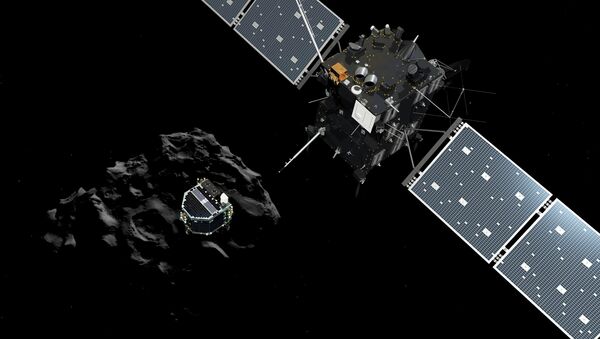The Rosetta spacecraft has just scored another historic first by making the closest flyby of the comet 67P/Churyumov–Gerasimenko it has been following and studying since last August.
12:41 UT: At closest approach to #67P!
— ESA Rosetta Mission (@ESA_Rosetta) 14 февраля 2015
The probe passed mere 6 kilometers (3.7 miles) from the surface of the ice ball in a unique display of affection on the Valentine’s Day. Taking into account the scale of the universe, it might well be considered a kiss on the cheek.
Close flyby will let me taste & sniff innermost parts of #67P's coma, & take measurements of surface at diff wavelengths #LivingWithAComet
— ESA Rosetta Mission (@ESA_Rosetta) 14 февраля 2015
In November, Rosetta sent a smaller probe, Philae, to the surface of the comet. The unprecedented landing resulted in volumes of priceless data transmitted back to Earth, but the probe landed in shadow and had to go into hibernation mode after its batteries ran out. Rosetta has not been able to find the probe on the comet’s surface.
@mggtTaylor @ESA_Rosetta I'm very curious about Philae. Any news?
— Regina P (@repaveli_p) 14 февраля 2015
However, the February 14 mission was not about locating Philae. The daredevil flyby was supposed to let researchers sample the comet’s atmosphere and take high resolution shadow-free pictures of the enigmatic celestial body. The European Space Agency (ESA) promised to publish the images later this month.
Won’t be able to send back images right away from close flyby, but NAVCAM team should have pics by Mon. Hope I do a good job! #CometWatch
— ESA Rosetta Mission (@ESA_Rosetta) 14 февраля 2015
@ESA_Rosetta excited for your flyby — send us some pictures please! Will you wave to @Philae2014 as you go over ;-) #LivingWithAComet #67P
— Laura F (@dantsis87) 14 февраля 2015
Interestingly, Rosetta will never be able to get this close to the comet again. For the remainder of the year, the spacecraft will make numerous flybys at a distance ranging from 15 kilometers (9.3 miles) to 100 kilometers (62 miles), according to ESA.
Today [10 Feb] I’m 499 million km from Earth, 352 million km from Sun & getting ready for 6km flyby of #67P on Sat: http://t.co/Rn9RhgjfSt
— ESA Rosetta Mission (@ESA_Rosetta) 10 февраля 2015
Rosetta, launched in 2004, is on a mission to study 67P/Churyumov–Gerasimenko in order to determine whether comets brought water and simple organic molecules to Earth billions of years ago, paving the way for life.

